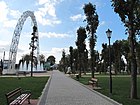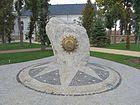Suchowola
Suchowola | |
|---|---|
 Church of Saints Peter and Paul in Suchowola | |
|
UTC+2 (CEST) | |
| Postal code | 16-150 |
| Vehicle registration | BSK |
| National roads | |
| Voivodeship roads | |
| Website | http://www.suchowola.com.pl |
Suchowola ([suxɔˈvɔla]; Lithuanian: Suchovola, Belarusian: Сухаволя Suchavolja) is a town in north-eastern Poland in Sokółka County in the Podlaskie Voivodeship, located on both banks of the Olszanka River. Its population is 2,196 (2017).
History
| Year | Pop. | ±% |
|---|---|---|
| 1921 | 2,457 | — |
| 1931 | 2,833 | +15.3% |
| 2010 | 2,186 | −22.8% |
| Source: [2][3][1] | ||
Suchowola was founded in the 16th century and in 1777 it was granted
During the Polish–Soviet War, the invading Soviets murdered five Poles in Suchowola on August 9, 1920.[4]
Following the joint German-Soviet
In November 1942, the Polish and German police rounded up the Jews in the ghetto. The sick and elderly were shot there. Others were loaded onto horse drawn carts or made to walk 34 miles to a transit camp in Kiełbasin, south of Grodno. Though most Jews in the transit camp were sent to Treblinka or Auschwitz, Suchowola's Jews were sent to the Grodno ghetto in December. Many Jews died there after contracting diseases in the transit camp. A few Suchowola Jews were able to escape and were sheltered by local Poles. There are thought to have been 23 Jewish survivors from Suchowola. Though several Polish auxiliary policemen were charged and tried for war crimes, after initial convictions, they were let off in the Polish postwar trials. A summary of Suchowola's wartime experiences can be found in the Encyclopedia of Camps and Ghettos.[6]
Due to serious losses in population during World War II, namely the entire Jewish population and some Poles who also lost their lives, the rights of a town were halted in 1950. On January 1, 1997, Suchowola became a town again. Polish priest Jerzy Popiełuszko, who was born in the nearby village of Okopy, was baptized in the local Church of Saints Peter and Paul. He also attended school in Suchowola. Currently, the municipal park by the church bears his name. His monument is located in the park, and in the town there is also a small museum dedicated to him.
Other sights include the historic Church of Saints Peter and Paul, and a boulder symbolizing the geographic centre of Europe, located in the municipal park. Many people still visit Suchowola today.
Cuisine
The officially protected
Gallery
-
Municipal park
-
Geographic centre of Europe boulder in the park
-
Jerzy Popiełuszko monument in the park
-
Well-preserved historic wooden architecture
Notable residents
- Zenon Mróz (born 1930), materials science engineer
References
- ^ a b Stan i struktura ludności oraz ruch naturalny w przekroju terytorialnym w 2010 r. (PDF) (in Polish). Warszawa: Główny Urząd Statystyczny. 2011. p. 88. Archived from the original (PDF) on 13 November 2011.
- ^ Skorowidz miejscowości Rzeczypospolitej Polskiej (in Polish). Vol. V. Warszawa: Główny Urząd Statystyczny. 1924. p. 71.
- ^ Wiadomości Statystyczne Głównego Urzędu Statystycznego (in Polish). Vol. X. Warszawa: Główny Urząd Statystyczny. 1932. p. 200.
- ISSN 1427-1443.
- ^ "Pamięci polskich oficerów zamordowanych w Katyniu, Twerze i Charkowie". isokolka.eu (in Polish). Retrieved 24 October 2021.
- ISBN 978-0-253-35599-7.
- ^ "Sękacz z Suchowoli". Ministerstwo Rolnictwa i Rozwoju Wsi - Portal Gov.pl (in Polish). Retrieved 24 October 2021.
External links
 Media related to Suchowola at Wikimedia Commons
Media related to Suchowola at Wikimedia Commons





